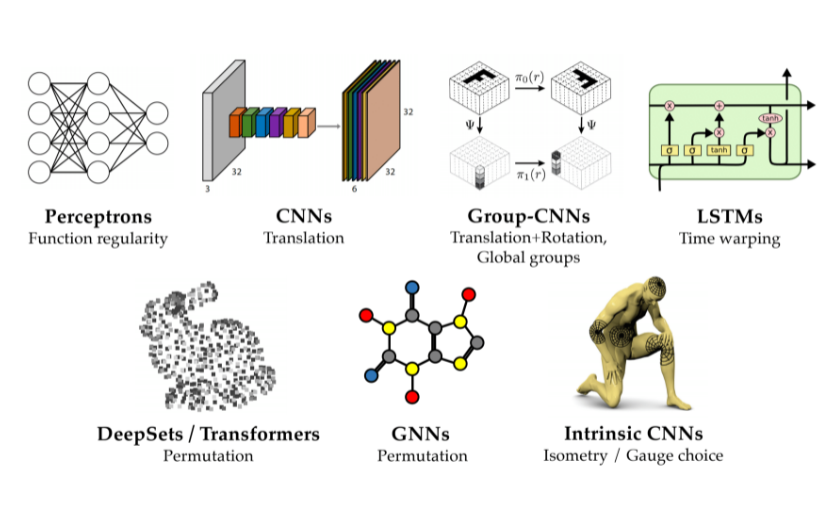An introduction to Graph Neural Networks
Carolina Cuesta-Lazaro
25th November 2021 - IAC-Deep





\vec{x}_n = [M_n, x_n, y_n,z_n]
\vec{x}_1
\vec{x}_2
\vec{x}_3
\vec{x}_4
\vec{y} = \frac{\sum_n M_n (x_n, y_n, z_n)}{\sum_n M_n}
f
\vec{y}
Toy problem: Learn to compute the center of mass
\vec{x}_n = [M_n, x_n, y_n,z_n]
\vec{x}_1
\vec{x}_2
\vec{x}_3
\vec{x}_4
f
\vec{y}
\vec{x}_2
\vec{x}_3
\vec{x}_1
\vec{x}_4
\vec{x}_1
\vec{x}_2
\vec{x}_3
\vec{x}_4
\vec{x}_1
\vec{x}_2
\vec{x}_4
\vec{x}_3
Impose symmetries!
Toy problem: Learn to compute the center of mass
The Curse of Dimensionality


Convolutions: Reduce parameters
+ Translational Equivariance

f(Tx) = Tf(x)

f
Pooling: Translational Invariance
f(Tx) = f(x)

f
CAT

2x2 Max
Pooling

\vec{x}_1
\vec{x}_2
\vec{x}_3
\vec{x}_4
f(Px) = f(x)
Sets: Permutation Invariance
y = \bigoplus (
\vec{h}_1
\vec{h}_2
\vec{h}_3
\vec{h}_4
) = \bigoplus(
Permutation Invariant function: Mean, Avg, Sum, Max ...
\vec{h}_2
\vec{h}_3
\vec{h}_1
\vec{h}_4
)
y = g \left(\bigoplus_{i \in V} (f(x_i))\right)
Neural Nets
Deep Sets Zaheer et al, NeurIPS'18
\vec{x}_1
\vec{x}_2
\vec{x}_3
\vec{x}_4
f
f
f
f
f
\vec{x}_1
\vec{x}_2
\vec{x}_3
\vec{x}_4
\vec{h}_1
\vec{h}_2
\vec{h}_3
\vec{h}_4
\vec{x}_1
\vec{x}_2
\vec{x}_3
\vec{x}_4
f(Px) = Pf(x)
y_i =f(x_i)
Node Level
Permutation Equivariance
y = g \left( \bigoplus_{i \in V} (f(x_i)) \right)
Set Level
Permutation Invariance
f(Px) = f(x)
\vec{x}_1
\vec{x}_2
\vec{x}_3
\vec{x}_4
A = \begin{pmatrix}
0 & 0 & 0 & 1\\
0 & 0 & 1 & 0\\
0 & 1 & 0 & 1\\
1 & 0 & 1 & 0
\end{pmatrix}
Adjacency Matrix
Permutation Invariance:
f(Px, P A P^T) = f(x, A)
Permutation Equivariance:
f(Px, P A P^T) = Pf(x, A)
Aggregate features from local neighbourhood
\vec{x}_1
\vec{x}_2
\vec{x}_3
\vec{x}_4
Input Graph (x, A)
\vec{h}_3
f
Learned Graph (h, A)
\vec{h}_3 = \bigoplus(\vec{h}_2, \vec{h}_4)
\vec{x}_1
\vec{x}_2
\vec{x}_3
\vec{x}_4
Input Graph (x, A)
Learned Graph (h, A)
\vec{h}_3
\vec{h}_4
\vec{h}_2
\vec{h}_1
Node regression
/classification
z_i = g(h_i)
Graph regression
/classification
z_G = f(\bigoplus_{i \in V} h_i)
Link prediction
z_{ij} = f(h_i,h_j, e_{ij})
\vec{x}_1
\vec{x}_2
\vec{x}_3
\vec{x}_4
\vec{h}_i = g\left(\vec{x}_i, \bigoplus_{j \in N_i} f(\vec{x}_i, \vec{x}_j)\right)
\vec{h}_i = g\left(\vec{x}_i, \bigoplus_{j \in N_i} c_{ij} f(\vec{x}_j)\right)
CONVOLUTIONAL
MESSAGE PASSING
\vec{h}_i = g\left(\vec{x}_i, \bigoplus_{j \in N_i} a(\vec{x}_i, \vec{x}_j) f(\vec{x}_j)\right)
ATTENTIONAL
Transformers = Fully connected Graph Nets (attentional)!

\vec{h}_i = g\left(\vec{x}_i, \bigoplus_{j \in N_i} a(\vec{x}_i, \vec{x}_j) f(\vec{x}_j)\right)
Image Credit + More Info https://arxiv.org/abs/2104.13478

Geometric Deep Learning



Graph Neural networks
By carol cuesta
Graph Neural networks
- 570



